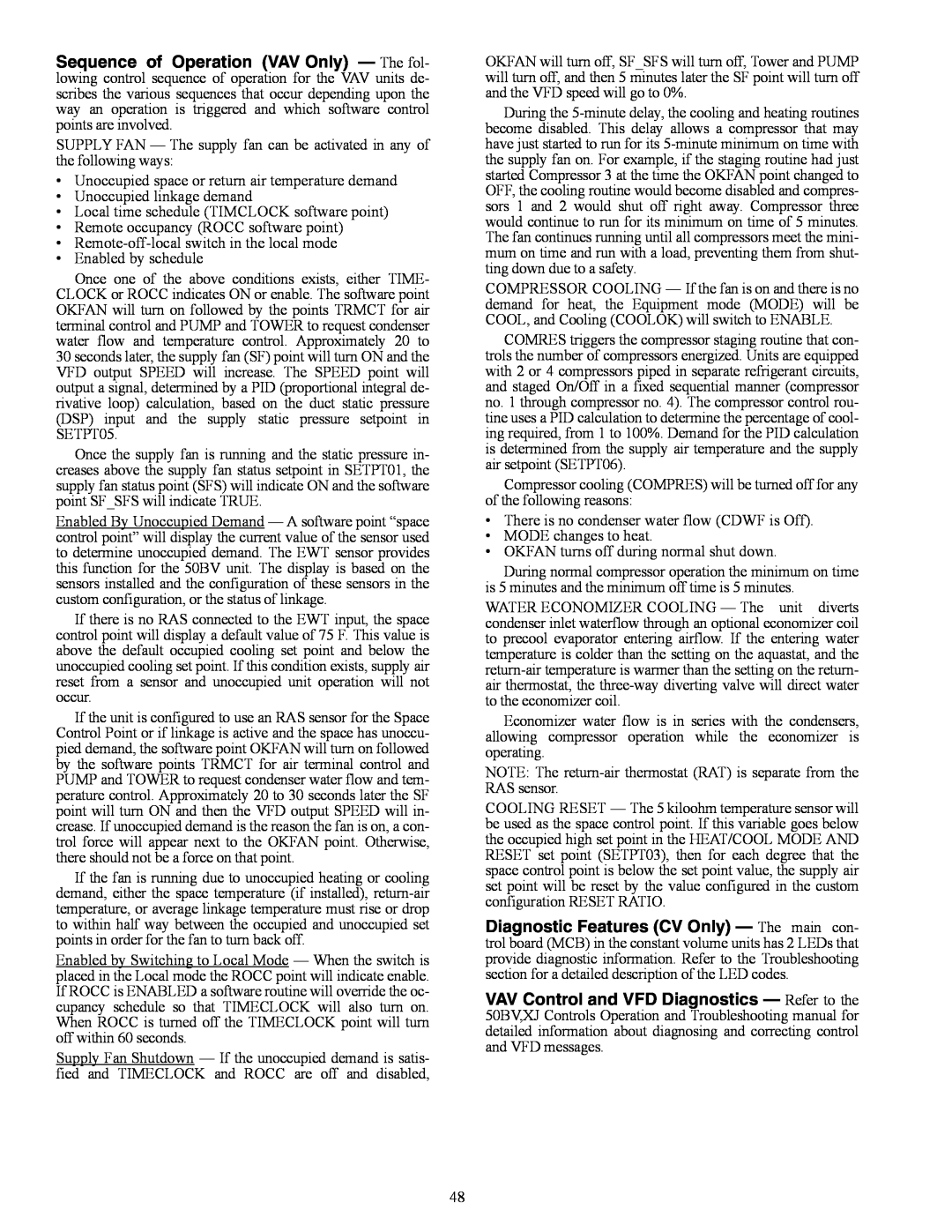Sequence of Operation (VAV Only) — The fol- lowing control sequence of operation for the VAV units de- scribes the various sequences that occur depending upon the way an operation is triggered and which software control points are involved.
SUPPLY FAN — The supply fan can be activated in any of the following ways:
•Unoccupied space or return air temperature demand
•Unoccupied linkage demand
•Local time schedule (TIMCLOCK software point)
•Remote occupancy (ROCC software point)
•
•Enabled by schedule
Once one of the above conditions exists, either TIME- CLOCK or ROCC indicates ON or enable. The software point OKFAN will turn on followed by the points TRMCT for air terminal control and PUMP and TOWER to request condenser water flow and temperature control. Approximately 20 to 30 seconds later, the supply fan (SF) point will turn ON and the VFD output SPEED will increase. The SPEED point will output a signal, determined by a PID (proportional integral de- rivative loop) calculation, based on the duct static pressure (DSP) input and the supply static pressure setpoint in SETPT05.
Once the supply fan is running and the static pressure in- creases above the supply fan status setpoint in SETPT01, the supply fan status point (SFS) will indicate ON and the software point SF_SFS will indicate TRUE.
Enabled By Unoccupied Demand — A software point “space control point” will display the current value of the sensor used to determine unoccupied demand. The EWT sensor provides this function for the 50BV unit. The display is based on the sensors installed and the configuration of these sensors in the custom configuration, or the status of linkage.
If there is no RAS connected to the EWT input, the space control point will display a default value of 75 F. This value is above the default occupied cooling set point and below the unoccupied cooling set point. If this condition exists, supply air reset from a sensor and unoccupied unit operation will not occur.
If the unit is configured to use an RAS sensor for the Space Control Point or if linkage is active and the space has unoccu- pied demand, the software point OKFAN will turn on followed by the software points TRMCT for air terminal control and PUMP and TOWER to request condenser water flow and tem- perature control. Approximately 20 to 30 seconds later the SF point will turn ON and then the VFD output SPEED will in- crease. If unoccupied demand is the reason the fan is on, a con- trol force will appear next to the OKFAN point. Otherwise, there should not be a force on that point.
If the fan is running due to unoccupied heating or cooling demand, either the space temperature (if installed),
Enabled by Switching to Local Mode — When the switch is placed in the Local mode the ROCC point will indicate enable. If ROCC is ENABLED a software routine will override the oc- cupancy schedule so that TIMECLOCK will also turn on. When ROCC is turned off the TIMECLOCK point will turn off within 60 seconds.
Supply Fan Shutdown — If the unoccupied demand is satis- fied and TIMECLOCK and ROCC are off and disabled,
OKFAN will turn off, SF_SFS will turn off, Tower and PUMP will turn off, and then 5 minutes later the SF point will turn off and the VFD speed will go to 0%.
During the
COMPRESSOR COOLING — If the fan is on and there is no demand for heat, the Equipment mode (MODE) will be COOL, and Cooling (COOLOK) will switch to ENABLE.
COMRES triggers the compressor staging routine that con- trols the number of compressors energized. Units are equipped with 2 or 4 compressors piped in separate refrigerant circuits, and staged On/Off in a fixed sequential manner (compressor no. 1 through compressor no. 4). The compressor control rou- tine uses a PID calculation to determine the percentage of cool- ing required, from 1 to 100%. Demand for the PID calculation is determined from the supply air temperature and the supply air setpoint (SETPT06).
Compressor cooling (COMPRES) will be turned off for any of the following reasons:
•There is no condenser water flow (CDWF is Off).
•MODE changes to heat.
•OKFAN turns off during normal shut down.
During normal compressor operation the minimum on time is 5 minutes and the minimum off time is 5 minutes.
WATER ECONOMIZER COOLING — The unit diverts condenser inlet waterflow through an optional economizer coil to precool evaporator entering airflow. If the entering water temperature is colder than the setting on the aquastat, and the
Economizer water flow is in series with the condensers, allowing compressor operation while the economizer is operating.
NOTE: The
COOLING RESET — The 5 kiloohm temperature sensor will be used as the space control point. If this variable goes below the occupied high set point in the HEAT/COOL MODE AND RESET set point (SETPT03), then for each degree that the space control point is below the set point value, the supply air set point will be reset by the value configured in the custom configuration RESET RATIO.
Diagnostic Features (CV Only) — The main con- trol board (MCB) in the constant volume units has 2 LEDs that provide diagnostic information. Refer to the Troubleshooting section for a detailed description of the LED codes.
VAV Control and VFD Diagnostics — Refer to the 50BV,XJ Controls Operation and Troubleshooting manual for detailed information about diagnosing and correcting control and VFD messages.
48
